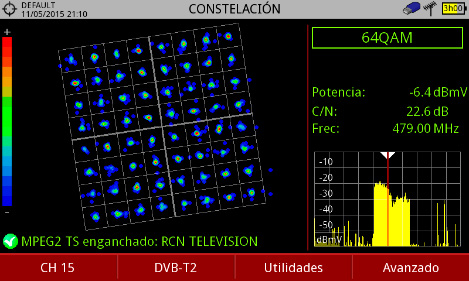OFDM comparison with FFT and DWT processing for DVB-T2 wireless channels
DOI:
https://doi.org/10.17981/ingecuc.14.2.2018.09Keywords:
Wireless channel, AWGN noise, fading, broadband communications, DWT and FFTAbstract
Introduction: Recent studies on the FFT processing (Fast Fourier Transform) or DWT (Discrete Wavelet Transform) of the OFDM signal (Orthogonal Frequency Division Multiplexing) have shown pros and cons for DVB-T2 (Digital Video Broadcasting-Second Generation Terrestrial) radio communications; however, the benefits of both types of processing have yet to be compared for the same scenario.
Objective: The objective of this research is to compare the response of the wireless channel with AWGN noise (Additive White Gaussian Noise Channel) and Rayleigh and Rician fading in the UHF (Ultra High Frequency) band.
Methodology: The transmission of DVB-T2 information with OFDM modulation and FFT and DWT processing was simulated in Matlab®, specifically in Simulink.
Results: The results of the study proved to be more efficient for DWT system than FFT system, due to the low rate of erroneous bits, spectral efficiency and reduction of the Peak-to-Average Power Ratio (PAPR), for Eb / No relations greater than 10dB.
Conclusions: In this article, we present the designs of both systems and the results of the research experience; likewise, the practical applicability of these systems is discussed, and improvements are suggested for future work.
Downloads
References
M. Kolomytsey, A. Lipatov and A. Lyagoskin, “Statement of Problem for Synchronous Digital Television Network Planning”, CriMiCo, 2007, pp. 287-288.
K. Abdullah and Z. Hussain, “Studies on DWT-OFDM and FFT-OFDM Systems”, ICCCP, 2009.
K. Abdullah and Z. Hussain, “Impulsive Noise Effects on DWT- and WPTOFDM versus FFT-OFDM”, ICCCP, 2009.
G. Cherubini, E. Eleftheriou and S. Oelser, “Filtered Multitone Modulation for High-Speed DSL”, IEEE Journal of Selected Areas in Communications, Vol. 20, no. 5, 2002. https://doi.org/10.1109/JSAC.2002.1007382
H. Paz, Digital communications systems, Bogotá DC, Colombia: Escuela Colombiana de Ingeniería, 2009.
L. Schulze, Theory and Applications of OFDM and CDMA–Wideband Wireless Communications, UK: John Wiley and Sons, 2005, pp. 408. https://doi.org/10.1002/0470017406
ETSI Technical Specification, “Digital Video Broadcasting: System Specifications for Satellite Services to Handheld Devices (SH) below 3GHz”, ETSI TS 102-585, V.1.1.1, 2007.
ETSI European Standard, “Digital Video Broadcasting (DVB): Second generation framing structure, cannel coding and modulation systems for Broadcasting, Interactive Services, News Gathering and other broadband satellite applications (DVB-S2)”, EN 302 307 V. 1.2.1, 2008.
M. García, S. Ruiz and F. Minerva, “Static delays optimization to reduce self-interference in DVB-T networks. Broadband Multimedia Systems and Broadcasting (BMSB)”, IEEE PIMRC, 2010, pp. 1-6.
R. Dilmirghani and M. Ghavami, “Wavelet Vs Fourier Based UWB Systems”, IEEE PIMRC, 2007, pp. 1-5.
D. Gupta, H. Torry, V. Vats and K. Garg, “Performance Analysis of DFT-OFDM, DCT-OFDM and DWT-OFDM Systems in AWGN Channel”, ICWMC, 2008.
S. Baig, U. Rehman and M. Mughal, “Performance comparison of DFT, discrete wavelet packet and wavelet transforms, in an OFDM transceiver for multipath fading channel”, in Proc. INMIC, 2005, pp. 1-6. https://doi.org/10.1109/INMIC.2005.334509
W. Saad, N. El-Fishawy, S. El-Rabaie and M. Shokair, “An Efficient Technique for OFDM System Using Discrete Wavelet Transform”. In: Bellavista P., Chang RS., Chao HC., Lin SF., Sloot P.M.A. (eds) Advances in Grid and Pervasive Computing. GPC 2010. Lecture Notes in Computer Science, Vol 6104, pp. 533-541. Springer, Berlin, Heidelberg, 2010.
P. Gonzáles, N. Pérez, J. Paredes, J. Uzcategui, J. Pena, L. da Silva, R. Lima and L. Silva, “Measurements of Terrestrial Digital TV Signals at Two Cities in South America”, EUCAP, 2010.
ACIEM, “¿Qué aspectos técnicos debe contener el DVBT2?”, ACIEM, Vol. 114, pp. 21-23, March 2012.

Downloads
Published
How to Cite
Issue
Section
License
Published papers are the exclusive responsibility of their authors and do not necessary reflect the opinions of the editorial committee.
INGE CUC Journal respects the moral rights of its authors, whom must cede the editorial committee the patrimonial rights of the published material. In turn, the authors inform that the current work is unpublished and has not been previously published.
All articles are licensed under a Creative Commons Attribution-NonCommercial-NoDerivatives 4.0 International License.


 English
English
 Español (España)
Español (España)






















